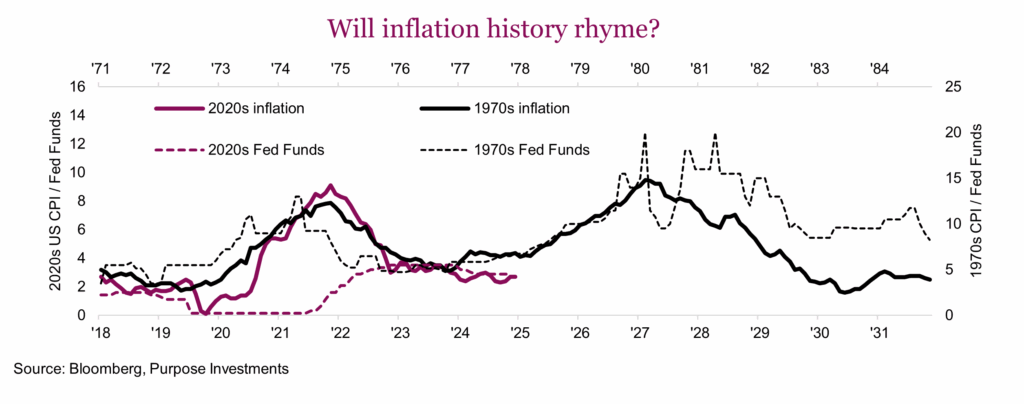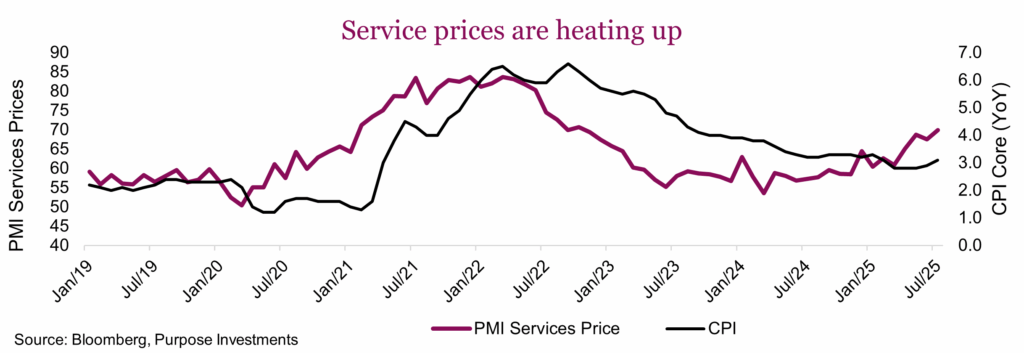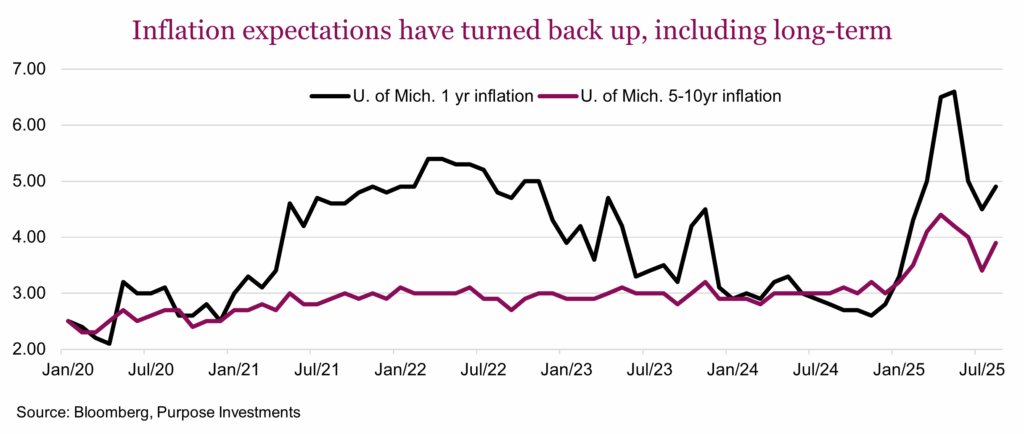Market Ethos
August 18, 2025
Inflation risks are adding up
Sign up here to receive the Market Ethos by email.
Few would disagree that the U.S. Fed was late to the game in fighting inflation a few years ago. Of course, it was a rather unique time in history coming out of a pandemic that had supply constraints still lingering while demand soared. People were bored sitting at home and had piles of accumulated savings, so revenge travel became a trend as did just paying up. After waiting too long, claiming inflation was transitory, central banks around the world moved rates up aggressively to combat inflation.
The chart below is kind of fun, contrasting the 70s with the 20s. In the 1970s, central bankers were on it, raising rates quickly to fight inflation. But after initial success it came back and then required rates to go even higher and stay up there longer to finally beat down inflation. This led to a pretty bad recession in the 80s, then a beautiful time for consumers and markets that lasted decades.

We are not saying 2020s inflation will follow the same path, that would be too simplistic. However, it does appear inflation may be stirring once again. Inflation has come down from a high of around 8.5% to the current 2.7% based on U.S. CPI year-over-year. This probably is not deemed a success from the central bank’s perspective, but it isn’t their fault. The Fed was late to get started but even when the hikes began, fiscal spending in the U.S. continued very aggressively with monetary policy pulling the rope in one direction and fiscal policy in the other. So apart from very interest rate-sensitive pockets of the economy, there really wasn’t much of a slowdown to alleviate the inflation pressures. Instead, they mainly came down because we all blew through accumulated savings, and the higher cost of doing things sped this process. And supply or capacity caught up with demand.
Unfortunately, inflation hasn’t come down as much as policy makers and consumers hoped. And it does potentially appear to be starting to turn back up. Meanwhile, the Fed is expected to cut rates in September, which would be the first rate cut in 2025. At the same time, a number of factors appear to be signaling that inflation may re-accelerate, which may cause some surprise for markets later in 2025.
Tariffs – As tariffs begin to be collected, they push prices higher, making them inflationary, but it also depends on how consumers respond. If higher prices result in less demand, slower economic activity could help offset inflation. But, with consumer spending still resilient, and renewed fiscal spending, the economy may not slow down or slow enough to mitigate the upward move in inflation from tariffs. With new and expanded tariffs starting to filter through the supply chain, tariff-driven cost increases usually take two-six months to fully show up in CPI. That means in Q4 we could start to see this impact, or sooner if companies choose to increase prices earlier.

Looking at earnings transcripts for mentions of rising costs and prices, it would appear companies are starting to raise prices already. Keep in mind this is for Q2, even before most of the tariffs started. Q3, which we will see in October, will likely be higher – a sign of more inflation ahead. The good news is that costs are not yet rising, which means profit margins may see a positive impact. This could be good for equities, not so much for bonds.
Services – Tariffs impact goods inflation but for developed economies, such as the U.S. and Canada, services matter more so. And for services, wages matter the most. Wage growth has been moderating slowly, but unless we start seeing material weakness in employment, wage growth will likely continue. PMI surveys for service business pricing has been accelerating to the upside, which historically leads to overall inflation.

Inflation is a mindset problem, and the real damage comes when people begin to think inflation is here to stay. This causes behaviours to change — from consumption to wage growth expectations. It is worth noting that the University of Michigan survey data didn’t see long-term inflation expectations (5-10 year) move higher during the 2021-22 inflation spike. But they are moving higher now, with a jump in this month’s survey. Partial erosion of Fed independence, whether real or perceived, is likely adding to the view that inflation may run hotter for longer, with less effective policy control.

Final thoughts
Reducing rates, adding more fiscal stimulus in the Big Beautiful Bill, and the impact of tariffs — inflation risks are adding up in the coming months. Of course, if we get a soft patch in the economic data, that may provide the release valve. But if we don’t get a slowdown, this inflation risk may bleed into yields in the coming months.



